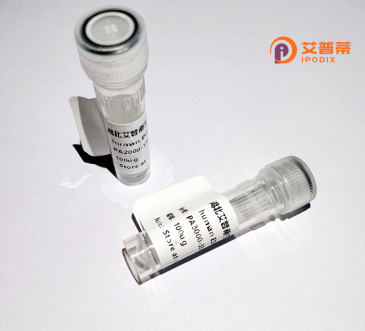
| 纯度 | >90%SDS-PAGE. |
| 种属 | Human |
| 靶点 | TMEM176B |
| Uniprot No | Q3YBM2 |
| 内毒素 | < 0.01EU/μg |
| 表达宿主 | E.coli |
| 表达区间 | 1-270 aa |
| 活性数据 | MTQNTVIVNGVAMASRPSQPTHVNVHIHQESALTQLLKAGGSLKKFLFHPGDTVPSTARIGYEQLALGVTQILLGVVSCVLGVCLSLGPWTVLRASGCAFWAGSVVIAAGAGAIVHEKHPGKLAGYISSLLTLTGFATAMAAVVLCVNSFIWQTEPFLYIDTVCDRSDPVFPTTGYRWMRRSQENQWQKEECRAYMQMLRKLFTAIRALFLAVCVLKVIVSLVSLGVGLRNLCGQSSQPLNEEGSEKRLLGENSVPPSPSREQTSTAIVL |
| 分子量 | 55.6 kDa |
| 蛋白标签 | GST-tag at N-terminal |
| 缓冲液 | PBS, pH7.4, containing 0.01% SKL, 1mM DTT, 5% Trehalose and Proclin300. |
| 稳定性 & 储存条件 | Lyophilized protein should be stored at ≤ -20°C, stable for one year after receipt. Reconstituted protein solution can be stored at 2-8°C for 2-7 days. Aliquots of reconstituted samples are stable at ≤ -20°C for 3 months. |
| 复溶 | Always centrifuge tubes before opening.Do not mix by vortex or pipetting. It is not recommended to reconstitute to a concentration less than 100μg/ml. Dissolve the lyophilized protein in distilled water. Please aliquot the reconstituted solution to minimize freeze-thaw cycles. |
以下是关于重组人TMEM176B蛋白的3篇参考文献及其摘要概括:
1. **文献名称**:*TMEM176B modulates TLR-mediated innate immune signaling in dendritic cells*
**作者**:Luo X, et al.
**摘要**:研究发现TMEM176B通过抑制TLR信号通路(如TLR4/NF-κB)负向调控树突状细胞的免疫激活功能,可能参与自身免疫疾病的病理机制。
2. **文献名称**:*TMEM176B acts as a tumor suppressor in melanoma by regulating MAPK signaling*
**作者**:Guérin C, et al.
**摘要**:该文揭示TMEM176B在黑色素瘤中低表达,其重组蛋白通过调控MAPK信号通路抑制肿瘤细胞增殖并促进凋亡,提示其作为潜在治疗靶点。
3. **文献名称**:*Structural and functional characterization of human TMEM176B as a cation channel*
**作者**:García-Añoveros J, et al.
**摘要**:首次解析TMEM176B的跨膜结构,证实其具有阳离子通道功能,参与调控溶酶体pH稳态,可能影响神经退行性疾病相关通路。
4. **文献名称**:*Recombinant TMEM176B protein enhances autophagy in renal tubular cells*
**作者**:Wang Y, et al.
**摘要**:通过体外实验证明,重组TMEM176B蛋白可促进肾小管细胞自噬,减轻缺血再灌注损伤,机制与mTOR信号通路抑制相关。
以上文献均涉及TMEM176B在免疫、肿瘤、离子通道及疾病模型中的功能研究,可作为进一步探索的参考。
**Background of Recombinant Human TMEM176B Protein**
Transmembrane protein 176B (TMEM176B) is a poorly characterized protein belonging to the TMEM family, which consists of integral membrane proteins with diverse roles in cellular physiology. It is primarily expressed in immune cells, such as macrophages and dendritic cells, and is implicated in modulating innate immune responses. Studies suggest TMEM176B acts as a negative regulator of the NLRP3 inflammasome, a key component of the inflammatory cascade, by potentially disrupting ion flux or autophagy-related pathways.
Structurally, TMEM176B contains two predicted transmembrane domains and a conserved ectodomain, though its precise molecular mechanism remains unclear. It shares homology with TMEM176A, forming heterodimers that may influence immune tolerance. Recent research highlights its potential role in cancer immunotherapy, as TMEM176B expression correlates with tumor microenvironment remodeling and immune evasion, possibly through interactions with PD-1/PD-L1 signaling.
Recombinant TMEM176B protein, produced via mammalian or insect cell systems, retains post-translational modifications critical for its function. It serves as a tool for studying autoimmune diseases, neurodegenerative disorders, and cancer immunology. However, gaps persist in understanding its ligands, signaling partners, and tissue-specific roles, necessitating further exploration of its therapeutic potential as a drug target or biomarker.
×